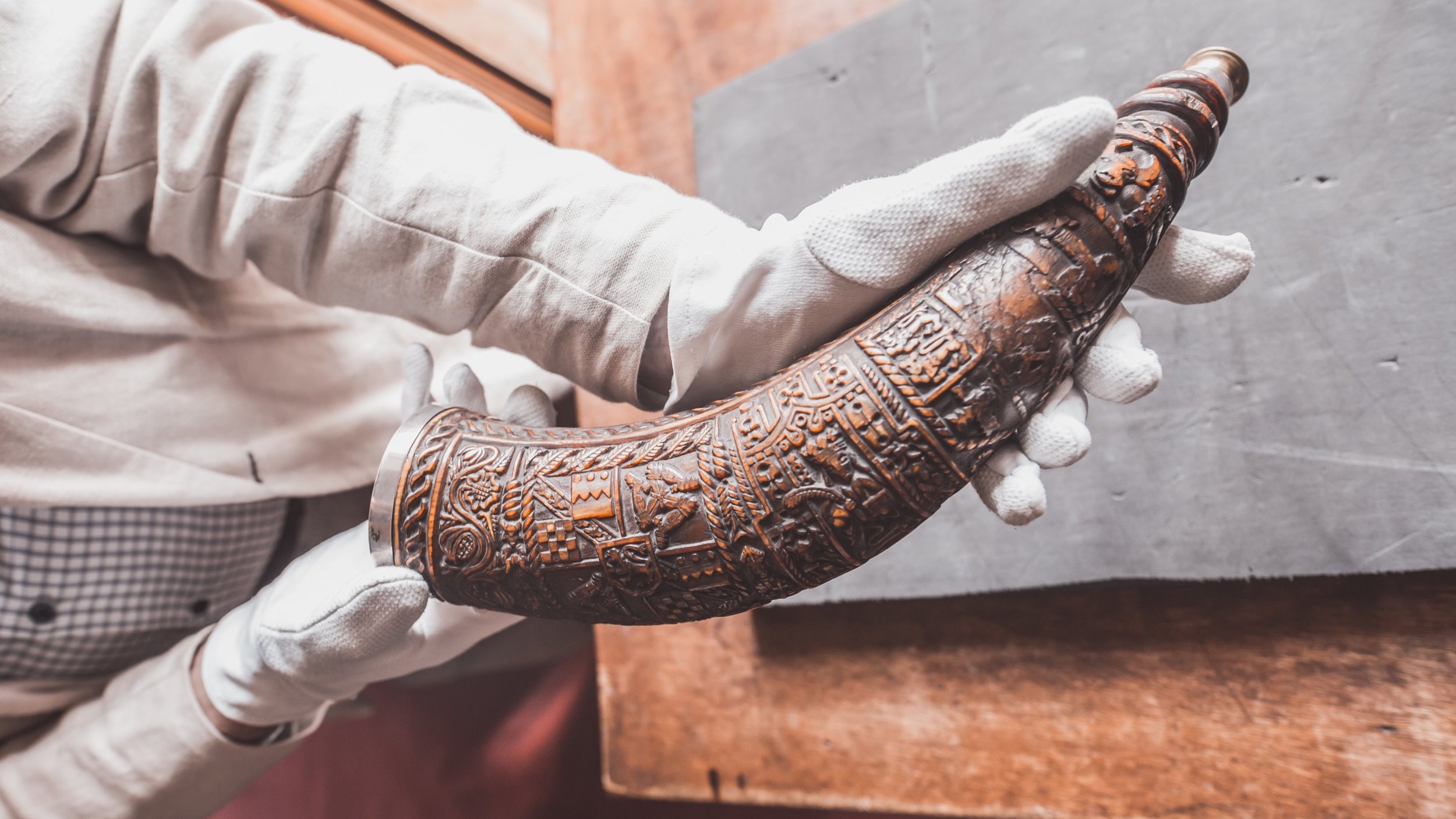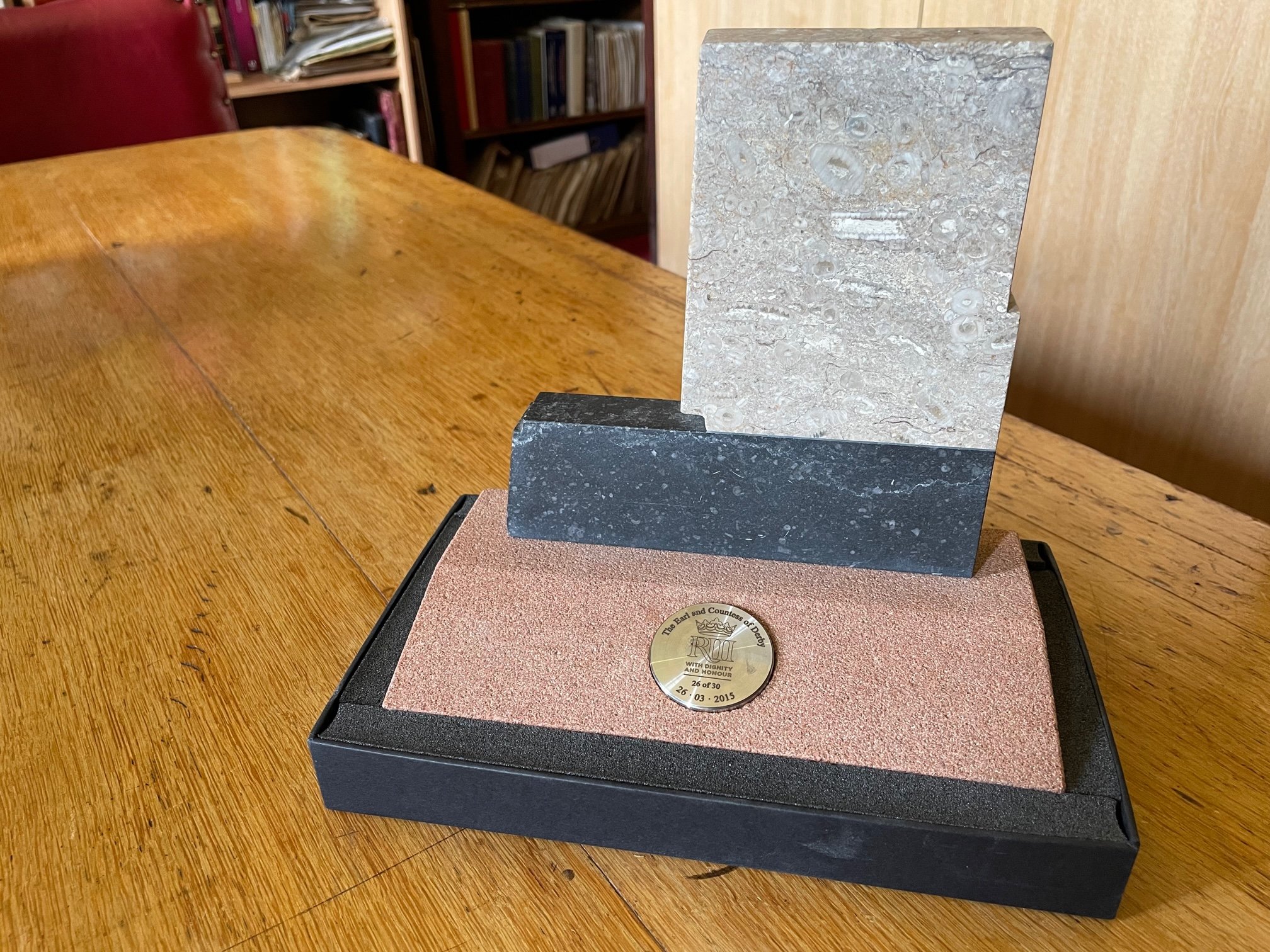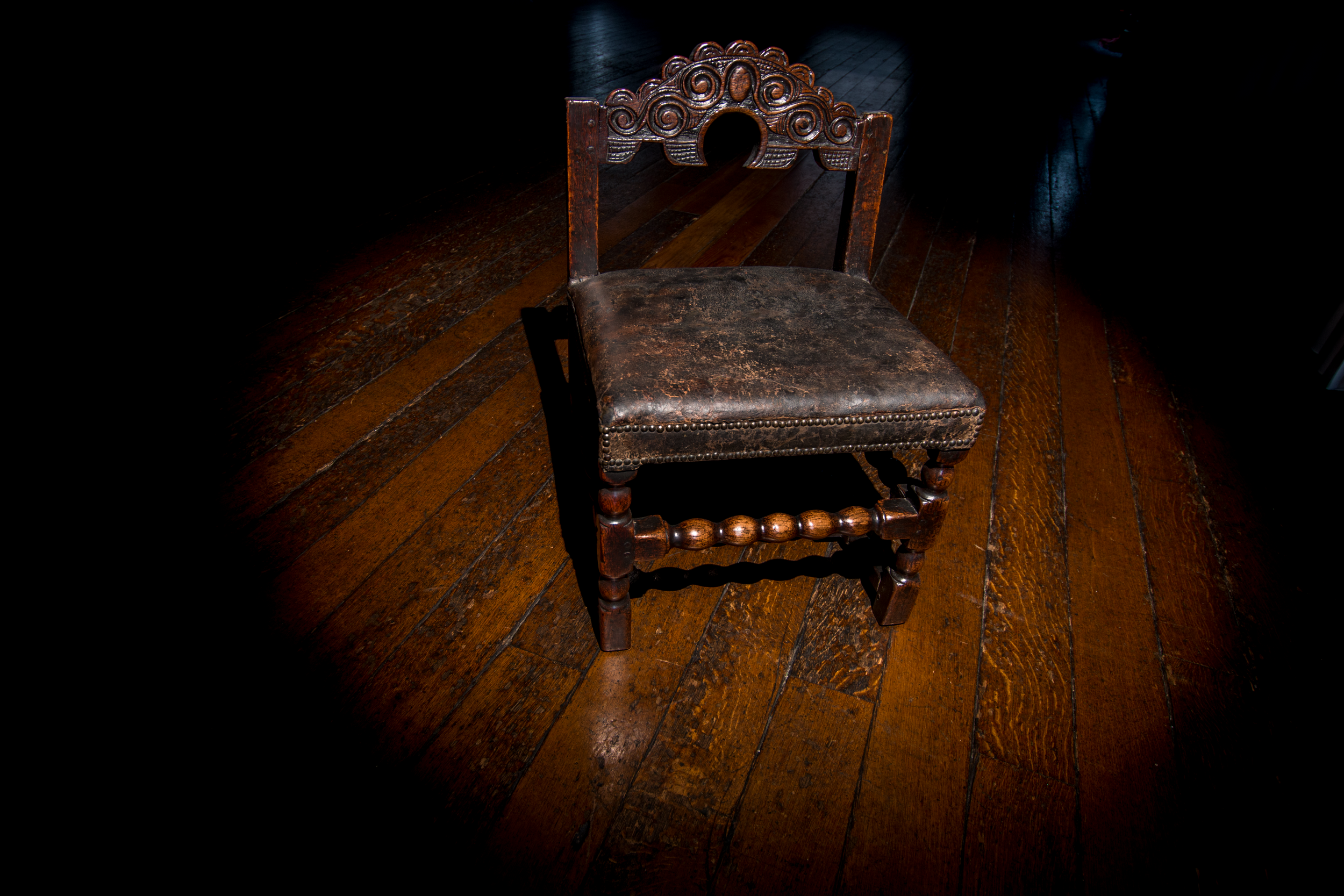The Stanley Family: from the Battle of Bosworth to the English Civil War 1385-1651
Let’s start with Episode 1, which I have called The Stanley Family: from the Battle of Bosworth to the Civil War 1385-1651. During this episode I have the honour to talk to media stalwart Dan Snow about the last battle of the protracted and bloody Wars of the Roses of the 15th century – the Battle of Bosworth at which our family played such a pivotal role.
I show Dan ‘the Bosworth Horn’ that we found right in the depths of the vaults at Knowsley Hall in 2018. It was black, but upon some sensitive cleaning by our Curator Dr Stephen Lloyd and Head Butler Jonathan Cullum it revealed itself to be a carved cow-horn originally used for drinking, with additional silver mounts and a brass mouthpiece so that it could be blown as a trumpet-like horn. The cow-horn itself has been radiocarbon dated to between 1468 and 1636, while the silver mounts of this musical mouthpiece and rim are hallmarked and dated 1808. So, it cannot be a Victorian fake. What we had found was the real deal and beyond exciting. Our butler is an expert in genealogy, and he discovered that all the heraldic carving on the cow horn is that appertaining to Thomas Stanley, 2nd Earl of Derby (1484-1521). There also appears to be a figure of a King, presumably Henry VII, Henry Tudor, supported by a bishop and a warrior (pictorial imagery to represent the crown as being supported by the church and the army). Lord Thomas Stanley crowned his stepson, Henry Tudor at the Battle of Bosworth in 1485, when Richard III was killed on the battlefield by Stanley’s Lancastrian troops, and he was co-incidentally grandfather to the boy born in 1484 – the future 2nd Earl. According to a document at Knowsley Hall from 1887 the horn was exhibited in the Walnut Drawing Room at Knowsley, stating that it was found on the Bosworth battlefield. Having descended through the Kett, Thomson and Canterbury families it was presented to, Edward Henry Stanley, 15th Earl of Derby and his wife Lady Mary, who proudly displayed it.
Above: ‘The Bosworth Horn’ carved cow-horn with silver mounts; image courtesy of the Derby Collection
I also showed Dan a very special momento I was given in March 2015 by Leicester Cathedral, when both my husband and I attended the burial of Richard III’s recently discovered skeleton underneath a nearby car park. Richard III was the last Plantagenet monarch; his mortal remains had been lost as there was no headstone or marking of his grave. Leicester Cathedral held a very historic and memorable event which I was honoured to attend as a member of the Neville family, as King Richard had been married to Queen Anne Neville. My husband held the pall (or cloth) over the coffin with three other descendants of the peers from the Battle of Bosworth. The master mason James Elliot, who made the stone tomb in 2015 from Swaledale fossil, Kilkenny limestone and Bowscar sandstone, also made some smaller segments of the tomb to give to certain people who officiated at the reinterment of Richard’s remains with dignity and honour as a special treasure.
Above: Souvenir made of three stones from the new tomb of King Richard III in Leicester; image courtesy of the Derby Collection
In this same episode I also show Dan some gruesome artefacts of the martyr James Stanley, the 7th Earl of Derby, who was beheaded in the marketplace at Bolton on 15 October 1651. I show him the actual execution stool with its carved back and upholstered leather seat that he sat on prior to his beheading, which would have been on a wooden block. This stool was presented in 1856 to the Prime Minister Edward Geoffrey, 14th Earl of Derby by James Hardcastle of Bolton-le-Moors, the mayor of Bolton. At Knowsley there is a large scrapbook bound in blue velvet known as Lady Constance’s blue book, in which there are two black-and-white photographs from the 1870s. One shows the actual clothes that the martyr Earl wore that day, while the other shows the receipt for a loan of £50 to the Earl from William Prescott of Ayrfield in 1648. Imagine our excitement when Colin Prescott, the direct descendant of William Prescott, wrote to us and said he still had these relics and would we like to see them. When Colin Prescott’s father died in 2007, Colin was handed a locked chest which contained the dark leather skull cap, the suede gauntlet gloves, a fine linen collar with two exquisite tassels and a brass spur of the martyr Earl, which were all given to Colin Prescott’s forbear on the day of the Earl’s execution. The sum of the £50 loan to the Earl equates to around £5,000 in today’s money. There is no evidence that the family paid the loan back and the Prescot family have been trustworthy custodians of the Earl’s last possessions ever since, including a sixpence from his pocket as well as a piece of the wooden block that he leant his head on. Since then, the relics have been conserved by the Liverpool Conservation Centre. Thanks to research done on the collar, we now know what the Earl ate for his last meal and that thankfully he was allowed a last glass of red wine, a nod to his stature.
Above: The Execution Chair of 7th Earl of Derby; image courtesy of the Derby Collection
In this same episode I also show Dr William Shannon the funeral book and posthumous property inventory of the 4th Earl of Derby from 1593-94. Bill Shannon could read the calligraphy of the book and identified the names of the pages who attended the procession of the deceased Earl and how much black silk went to the various page boys and other attendants including a certain William Kempe, actor in Lord Strange’s Players and colleague of William Shakespeare. More about that in next week’s episode when I speak to Dr Vanessa Wilkie and Professor Elspeth Graham about the Earls of Derby and their connection with Shakespeare. It is a tantalising tale that we have now uncovered a direct connection to, so don’t forget to listen in.
I hope you enjoy listening to this episode. Tune in here.



